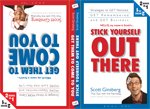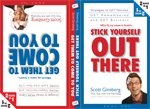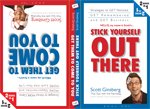 The word “prolific” comes from the Latin prolificus, which means, “to make offspring.”
The word “prolific” comes from the Latin prolificus, which means, “to make offspring.”
Which, if you think about it, is exactly what you do all day:
Give birth to your creative brainchildren.
The cool part is, the more prolific you are:
The more profit you earn.
The more love you spread.
The more gravity you defy.
The more legacy you leave.
The more people you touch.
The more purpose you fulfill.
The more change you inspire.
The more wisdom you amass.
The more worlds you conquer.
The more fans you accumulate.
The more significance you realize.
What did you create today?
Whether you’re an entrepreneur, writer or ad agency art director, here’s a list of how to be more prolific than you ever thought possible:1. Never be an aspiring anything. Aspiring is for amateurs. Make the decision to be “an.” There’s no someday I’ll. There’s no pre-heat. You either are or you aren’t.
Whatever you want to become, you can start being that thing (today!) by creating as much as you possibly can, as fast as you possibly can. Otherwise, if you put off being prolific until the right people stamp your creative passport, you’ll consign yourself to burning in the purgatory of wannabe.
Remember: Being prolific beings with the mindset that you already are what you want to become. Are you acting as if?
2. Metabolize your life. That’s the singular source for informing your art. As Anne Lamout, author of Bird By Bird once said, “Art is whatever remains after the fire.”
My question is: Does your life burn? If so, you’ll be more prolific than you ever imagined. As long as you focus on translating all that you experience into something more expressive.
After all, art is nothing but the residue of a life fully lived. Screw being a great artist – focus on being a great human first. Bring all of who you are to your creative work and trust that the art will come. How boring is your life?
3. Right isn’t as important as right direction. You don’t need to know where you’re going to be moving in the right direction. At least that’s what my fortune cookie told me yesterday.
Either way, when it comes to being prolific, what matters is that you simply get something down – every day. Maybe it sucks. Maybe it rocks. Maybe it’s just okay. Fine. Awesome. Perfect.
All you need to remember is: When you put pen to paper, you have the power. When you put finger to keyboard, brush to canvas, blade to clay or reed to mouth, you have the power. Just begin with what is – you can make something beautiful out of it later. Are you willing to plunge forward planless?
4. Extend literary latitude. I read five books a week. Some rock my face off; some make me want to blow my head off. Either way, I love them all, and I attend to them all with deep democracy.
That’s what prolific people practice: You don’t have to like something to learn from it; and you don’t have to get it to get something out of it. Sometimes bad work is exactly what you need to inspire good work.
Your mission is experience what you experience with a posture of openness and possibility. Because if you give yourself permission, you can become inspired by everything in sight. And that’s when you start to crank out volumes of work that matters. Are you a mental omnivore?
5. Be a brilliant fixer. Whenever I’m reading, I’m writing. In my experience, it’s just too hard to separate the two. For example, when I’m not underlining passages, jotting down transient ideas, documenting adjacent thoughts or questioning the author’s arguments – I’m fixing.
I can’t help it – that’s just what I do. It’s in my blood, and getting a transfusion would simply be too expensive.
The cool part is, many of my best ideas came from something as simple as changing or adding a single word to an existing sentence.
Examples: “A mind is a terrible thing to chase,” “A penny saved is an opportunity burned” and “All the world’s a page.” Your challenge is to incorporate some form fixing into your own creative process.
You’ll find that it’s fun, challenging, energizing and the raging river of raw material never stops flowing. How are you improving on everything that’s wrong with everything else on the shelves?
6. Be careful not to slide into complacency. Yes, remember your victory dance. Yes, take pride in your creative victories. But don’t over celebrate. Booking a weeklong trip to Vegas just because you finished your final draft three weeks before deadline as a bit excessive.
Never trust the prosperity that accompanies prolificacy. Instead, regularly reinstate your humility with the birth of every new brainchild.
As Starbucks CEO Howard Schultz reminds us, “Seek to renew yourself, even when you’re hitting homeruns.”
Remember: The arrogance of past victory is the aerosol of future failures. What are you sacrificing by watching your own touchdown dance on the jumbotron?
7. Get good at recognizing beginnings. The reason prolific professionals are masters at starting, progressing and executing their projects – is because they’ve perfected the art of seed spotting.
They estimate movement value early.
They see everything with the eyes of the future.
And they take action on those concepts without delay.
That’s the mark of prolificacy: Lots of irons in lots of fires. Working on multiple projects simultaneously. Doing so helps you create thought bridges, subconscious connections and unexpected integrations between (seemingly) unrelated ideas.
As a result, you will automatically notice natural relationships and structures in your work. What’s more, your creative efforts are more productively deployed when you start multiple projects simultaneously.
Yes, it requires considerable self-regulation to pursue multiple projects concurrently. But by shifting between ideas as circumstances dictate, you never get burned out and always execute without remorse. What did you start today?
8. Become a master of your disinclination. In the documentary I’m Your Man, songwriter and poetry legend Leonard Cohen reminds us, “You gotta go to work everyday, knowing that you’re not going to get it everyday.”
The secret is cultivating an acute sense of when disinclination is around the corner.
Personally, if I don’t get anything good after about an hour – I go back to bed. Sometimes for twenty minutes, sometimes for three hours. I’ve followed this rule for eight years and have never, ever failed to come back to the page refreshed and reenergized.
What’s more, I almost always go on to pound out something amazing. Lesson learned: Discover what frustrates your ambitions. Know when you’ve got it, known when you’ve lost it, know when there’s no way in hell you’re going to get it, and know when you’re going to have to take measures to get it back.
Hey, it happens. Resistance can be a feisty little bitch. Don’t be afraid to let her win every once in a while. Create around the constraint. It demonstrates humility for the process and motivates you to return with strength. What’s your policy for managing compositional paralysis?
9. Let less happen. Increasing your capacity to execute isn’t just about what you do – it’s also about what you avoid, what you stop doing and what you stop thinking.
For example, my friend Steve recently shared a staggering statistic with me: “On any given workday,” he said, “fifty to sixty percent of the tasks I do are meaningless.”
After I reconnected my jaw to my tear-soaked cheeks and unhooked my cold, dead hands from Steve’s unproductive throat, I began thinking about my own ratio. And it occurred to me that one of the reasons I’m so prolific is because ninety-eight percent of the work I do every day, matters.
No wonder I just finished my eleventh book at the age of thirty: Distractions are at an all-time low; execution is at an all time high. Better enjoy it now while it lasts.
Lesson learned: Excise every ounce of fat from your process. Discard the irrelevant. Then throw your shoulder into the work that matters. Be lean or be left behind. Is what you’re doing – right now – contributing to your body of work or your ulcer?
10. Keep the reservoir full. Whether you’re a painter, entrepreneur, wood carver or throbbing-member-trashy-novelist, prolificacy – that is, cranking out killer work consistently – is a function of volume.
As a writer, for example, I built my own content management system. It’s nothing fancy, but it’s certainly more sophisticated than a box of colored folders filled with ideas scribbled on cocktail napkins or random scraps of paper.
Currently clocking in at about 75,000 items, my creative inventory is meticulously organized by topic, date, use, audience, etc. And every single day, I add more water to the reservoir. Some days more than others.
But I do it every day, without fail. Which means my inventory is indepletable. And that’s the secret behind building your reservoir, regardless of the medium in which you work: It equips your daily practice with creative rations long before the artistic famine strikes.
And when I say famine, I’m referring common distractions such as: Resistance, boredom, disinclination, laziness or that annoying fluffball Westie from next door who does nothing but yap-yap-yap all day long. How much water did you add to your creative reservoir today?
11. Insulate yourself from interruptions. Tolerate nothing. Even if you have to put a sign on your door reading, “Quiet. The art is coming.” Whatever it takes. This is your creative time, and it deserves to be approached as sacrosanct.
Resist the temptation to be squeezed by your surroundings. Otherwise you become muddied by triviality, swept into the undertow of inconsequentiality. And that’s a surefire recipe for low productivity.
The hard part is stockpiling enough self-control to be able to look at your most seductive interruptions – square in the eye – and say, “Nice try. But I’ve got work to do. Peace out.”
Email is the worst. You have to close the window down or else you’ll never execute anything that matters. What interruptions are you afraid to ignore?
12. Never lose your ear for what’s happening around you. If being prolific has historically been hard for you, I’ve got some bad news: You problem isn’t writer’s block – it’s hearing damage.
That’s all creativity is, anyway: Active listening. And it’s easy to screw up. Like Voltaire said, “Never let temptation pass lightly by – it may never come again.”
Lesson learned: People who are prolific listen. And they do so with their ears, eyes, minds, hearts or whatever other body part is available.
Lose that skill and you forfeit the entire game. Keep it healthy and you’ll never stop creating. What did you hear today?
FINAL THOUGHT: Let’s turn to Cicero, philosopher and uber-prolific writer.
In his book, On the Good Life, he explained the following:
“Philosophers must not be judged by individual utterances they may choose to offer. They must be judged, instead, by all their different statements put together and by the degree of consistency and coherence with this whole body of doctrine displays.”
KEY WORD: Whole body.
Because you’re not just creating one piece.
Or one song.
Or one book.
Or one project.
Or one website.
Or one piece of art.
You’re contributing to an ongoing, smokin’ hot body of work.
Because that’s what prolifics do.
With or without Viagra.
LET ME ASK YA THIS…
How prolific are you?
LET ME SUGGEST THIS…
For the list called, “13 Things Losers Do,” send an email to me, and you win the list for free!
* * * *
Scott Ginsberg
That Guy with the Nametag
Author, Speaker, Entrepreneur, Mentor
[email protected]
 The world’s FIRST two-in-one, flip-flop book!
The world’s FIRST two-in-one, flip-flop book!
Buy Scott’s comprehensive marketing guidebook on Amazon.com and learn how to GET noticed, GET remembered and GET business!

 “He’ll eat almost anything, idea wise, or he’ll at least chew on it. What he swallows is another matter. That’s partly because the psychedelic springs from a common-sense filled, well-informed, experience-tempered and morally solid soul.”
“He’ll eat almost anything, idea wise, or he’ll at least chew on it. What he swallows is another matter. That’s partly because the psychedelic springs from a common-sense filled, well-informed, experience-tempered and morally solid soul.” The world’s FIRST two-in-one, flip-flop book!
The world’s FIRST two-in-one, flip-flop book! “Nobody’s reading your blog because of your art. They’re reading your blog because the person you are inspires them. They’re not reading your blog because they’re thinking of buying your paintings, they’re reading your blog because the way you approach your work inspires them. It sets an example for them. It stands for something that resonates with them. It leads them to somewhere that they also want to go.”
“Nobody’s reading your blog because of your art. They’re reading your blog because the person you are inspires them. They’re not reading your blog because they’re thinking of buying your paintings, they’re reading your blog because the way you approach your work inspires them. It sets an example for them. It stands for something that resonates with them. It leads them to somewhere that they also want to go.” The world’s FIRST two-in-one, flip-flop book!
The world’s FIRST two-in-one, flip-flop book! Creativity isn’t about what you create – it’s about how you create it.
Creativity isn’t about what you create – it’s about how you create it. The world’s FIRST two-in-one, flip-flop book!
The world’s FIRST two-in-one, flip-flop book! Do you want to dramatically shrink your creative output?
Do you want to dramatically shrink your creative output? The world’s FIRST two-in-one, flip-flop book!
The world’s FIRST two-in-one, flip-flop book!